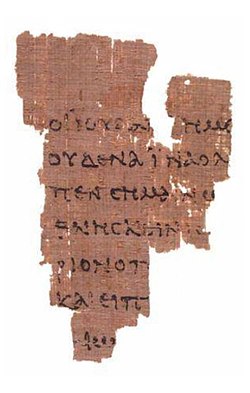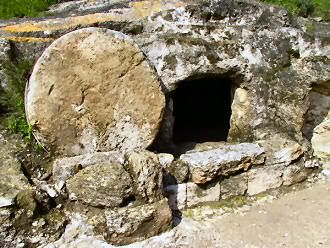The unknown Gospel of Egerton 2 was discovered in Egypt in 1935 exiting in two different manuscripts. The original editors found that the handwriting was that of a type from the late first early second century. In 1946 Goro Mayeda published a dissertation which argues for the independence of the readings from the canonical tradition. This has been debated since then and continues to be debated. Recently John B. Daniels in his Clairmont Dissertation argued for the independence of the readings from canonical sources.[4] Daniels states "Egerton's Account of Jesus healing the leaper Plausibly represents a separate tradition which did not undergo Markan redaction...Compositional choices suggest that...[the author] did not make use of the Gospel of John in canonical form." (Daniels, abstract).[5] The unknown Gospel of Egerton 2 is remarkable still further in that it mixes Johannie language with Synoptic contexts and vice vers. [6]The Unknown Gospel preserves a tradition of Jesus healing the leper in Mark 1:40-44. (Note: The independent tradition in the Diatessaran was also of the healing of the leper). There is also a version of the statement about rendering unto Caesar. Space does not permit a detailed examination of the passages to really prove Koster's point here. But just to get a taste of the differences we are talking about:
This is very significant because it indicates a reading independent of and therefore prior to Mark;s redaction,
. Koster:
"There are two solutions that are equally improbable. It is unlikely that the pericope in Egerton 2 is an independent older tradition. It is equally hard to imagine that anyone would have deliberately composed this apophthegma by selecting sentences from three different Gospel writings. There are no analogies to this kind of Gospel composition because this pericope is neither a harmony of parallels from different Gospels, nor is it a florogelium. If one wants to uphold the hypothesis of dependence upon written Gospels one would have to assume that the pericope was written form memory....What is decisive is that there is nothing in the pericope that reveals redactional features of any of the Gospels that parallels appear. The author of Papyrus Egerton 2 uses independent building blocks of sayings for the composition of this dialogue none of the blocks have been formed by the literary activity of any previous Gospel writer. If Papyrus Egerton 2 is not dependent upon the Fourth Gospel it is an important witness to an earlier stage of development of the dialogues of the fourth Gospel....(Koester , 3.2 p.215)[7]Gospel of Peter
Fragments of the Gospel of Peter were found in 1886 /87 in Akhimim, upper Egypt. These framents were from the 8th or 9th century. No other fragment was found for a long time until one turned up at Oxyrahynchus, which were written in 200 AD. Bishop Serapion of Antioch made the statement prior to 200 that a Gospel had been put forward in the name of Peter. This statement is preserved by Eusebius who places Serapion around 180. But the Akhimim fragment contains three periciopes. The Resurrection, to which the guards at the tomb are witnesses, the empty tomb, or which the women are witnesses, and an epiphany of Jesus appearing to Peter and the 12, which end the book abruptly.
Many features of the Gospel of Peter are clearly from secondary sources, that is reworked versions of the canonical story. These mainly consist of 1) exaggerated miracles; 2) anti-Jewish polemic.The cross follows Jesus out of the tomb, a voice from heaven says "did you preach the gospel to all?" The cross says "Yea." And Pilate is totally exonerated, the Jews are blamed for the crucifixion.[8] However, "there are other traces in the Gospel of Peter which demonstrate an old and independent tradition." The way the suffering of Jesus is described by the use of passages from the old Testament without quotation formulae is, in terms of the tradition, older than the explicit scriptural proof; it represents the oldest form of the passion of Jesus.[9] Jurgen Denker argues that the Gospel of Peter shares this tradition of OT quotation with the Canonicals but is not dependent upon them.[10] Koester writes, "John Dominic Crosson has gone further [than Denker]...he argues that this activity results in the composition of a literary document at a very early date i.e. in the middle of the First century CE" (Ibid). Said another way, the interpretation of Scripture as the formation of the passion narrative became an independent document, a ur-Gospel, as early as the middle of the first century![11]
Corosson's Cross Gospel is this material in the Gospel of Peter through which, with the canonical and other non-canonical Gospels Crosson constructs a whole text. According to the theory, the earliest of all written passion narratives is given in this material, is used by Mark, Luke, Matthew, and by John, and also Peter. Peter becomes a very important 5th witness. Koester may not be as famous as Crosson but he is just as expert and just as liberal. He takes issue with Crosson on three counts:
1) no extant text,its all coming form a late copy of Peter,
2) it assumes the literary composition of latter Gospels can be understood to relate to the compositions of earlier ones;
3) Koester believes that the account ends with the empty tomb and has independent sources for the epihanal material.
Koester:
"A third problem regarding Crossan's hypotheses is related specifically to the formation of reports about Jesus' trial, suffering death, burial, and resurrection. The account of the passion of Jesus must have developed quite eary because it is one and the same account that was used by Mark (and subsequently Matthew and Luke) and John and as will be argued below by the Gospel of Peter. However except for the appearances of Jesus after his resurrection in the various gospels cannot derive from a single source, they are independent of one another. Each of the authors of the extant gospels and of their secondary endings drew these epiphany stories from their own particular tradition, not form a common source....Studies of the passion narrative have shown that all gospels were dependent upon one and the same basic account of the suffering, crucifixion, death and burial of Jesus. But this account ended with the discovery of the empty tomb. With respect to the stories of Jesus' appearances, each of the extant gospels of the canon used different traditions of epiphany stories which they appended to the one canon passion account. This also applies to the Gospel of Peter. There is no reason to assume that any of the epiphany stories at the end of the gospel derive from the same source on which the account of the passion is based."[12]So Koester differs from Crosson mainly in that he divides the epiphanies up into different sources. Another major distinction between the two is that Crosson finds the story of Jesus burial to be an interpolation from Mark to John. Koester argues that there is no evidence to understand this story as dependent upon Mark.[14] Unfortunately we don't' have space to go through all of the fascinating analysis which leads Koester to his conclusions. Essentially he is comparing the placement of the pericopes and the dependence of one source upon another. What he finds is mutual use made by the canonical and Peter of a an older source that all of the barrow from, but Peter does not come by that material through the canonical, it is independent of them. That source is the Pre Mark Passion Narrative (PMPN)
"The Gospel of Peter, as a whole, is not dependent upon any of the canonical gospels. It is a composition which is analogous to the Gospel of Mark and John. All three writings, independently of each other, use older passion narrative which is based upon an exegetical tradition that was still alive when these gospels were composed and to which the Gospel of Matthew also had access. All five gospels under consideration, Mark, John, and Peter, as well as Matthew and Luke, concluded their gospels with narratives of the appearances of Jesus on the basis of different epiphany stories that were told in different contexts. However, fragments of the epiphany story of Jesus being raised form the tomb, which the Gospel of Peter has preserved in its entirety, were employed in different literary contexts in the Gospels of Mark and Matthew." [14]Also see my essay Have Gaurds, Will Aruge in which Jurgen Denker and Raymond Brown also agree about the indpeendent nature of GPete. Brown made his reputation proving the case, and pubulshes a huge chart in Death of the Messiah which shows the idendepnt nature and traces it line for line. Unfortunately I can't reproduce the chart.
What all of this means is, that there were independent traditions of the same stories, the same documents, used by Matthew, Mark, Luke and John which were still alive and circulating even when these canonical gospels were written. They represent much older sources and the basic work which all of these others use, goes back to the middle of the first century. It definitely posited Jesus as a flesh and blood man, living in historical context with other humans, and dying on the cross in historical context with other humans, and raising from the dead in historical context, not in some ethereal realm or in outer space. He was not the airy fairy Gnostic redeemer of Doherty, but the living flesh and blood "Son of Man."
Moreover, since the breakdown of Ur gospel and epiphany sources (independent of each other) demands the logical necessity of still other sources, and since the other material described above amounts to the same thing, we can push the envelope even further and say that at the very latest there were independent gospel source circulating in the 40s, well within the life span of eye witnesses, which were based upon the assumption that Jesus was a flesh and blood man, that he had an historical existence. Note: all these "other Gospels" are not merely oriented around the same stories, events, or ideas, but basically they are oriented around the same sentences. There is very little actual new material in any of them, and no new stories. They all essentially assume the same sayings. There is some new material in Thomas, and others, but essentially they are all about the same things. Even the Gospel of Mary which creates a new setting, Mary discussing with the Apostles after Jesus has returned to heaven, but the words are basically patterned after the canonical. It is as though there is an original repository of the words and events and all other versions follow that repository. This repository is most logically explained as the original events! Jesus actual teachings!
Canonical Gospels
The Diatessaon is an attempt at a Harmony of the four canonical Gospels. It was complied by Titian in about AD172, but it contains readings whihc imply that he used versions of the canonical gospels some of which contain pre markan elements.
In an article published in the Back of Helmut Koester's Ancient Christian Gospels, William L. Petersen states:
"Sometimes we stumble across readings which are arguably earlier than the present canonical text. One is Matthew 8:4 (and Parallels) where the canonical text runs "go show yourself to the priests and offer the gift which Moses commanded as a testimony to them" No fewer than 6 Diatessaronic witnesses...give the following (with minor variants) "Go show yourself to the priests and fulfill the law." With eastern and western support and no other known sources from which these Diatessaranic witnesses might have acquired the reading we must conclude that it is the reading of Tatian...The Diatessaronic reading is certainly more congielian to Judaic Christianity than than to the group which latter came to dominate the church and which edited its texts, Gentile Christians. We must hold open the possibility that the present canonical reading might be a revision of an earlier, stricter , more explicit and more Judeo-Christian text, here preserved only in the Diatessaron.[15]Summary and Conclusion
Koster and Crosson both agree that the PMR was circulating in written form with empty tomb and passion narrative, as early as 50AD
From this notion as a base line for the begining of the process of redaction, and using the traditional dates given the final product of canonical gospels as the base line for the end of the process, we can see that it is quite probable that the canonical gospels were formed between 50 and 95 AD. It appears most likely that the early phase, from the events themselves that form the Gospel, to the circulation of a written narrative, there was a controlled oral tradition that had its hay day in the 30's-40's but probably overlapped into the 60's or 70's. The say sources began to be produced, probably in the 40's, as the first written attempt to remember Jesus' teachings. The production of a written narrative in 50, or there abouts, probably sparked interest among the communities of the faithful in producing their own narrative accounts; after all, they too had eye witnesses.
Between 50-70's those who gravitated toward Gnosticism began emphasizing those saying sources and narrative pericopes that interested them for their seeming Gonostic elements, while the Orthodox honed their own orthodox sources that are reflected in Paul's choices of material,and latter in the canonical gospels themselves. So a great "drying up" process began where by what would become Gnostic lore got it's start, and for that reason was weeded out of the orthodox pile of sayings and doings. By that I mean sayings Like "if you are near to the fire you are near to life" (Gospel of the Savior) or "cleave the stone and I am there" (Thomas) "If Heaven is in the could the birds of the air will get there before you" (Thomas) have a seeming gnostic flavor but could be construed as orthodox. These were used by the Gnsotically inclined and left by the orthodox. That makes sense as we see the earliest battles with gnosticism beginning to heat up in the Pauline literature.
My own theory is that Mark was produced in several forms between 60-70, before finally coming to rest in the form we know it today in 70. During that time Matthew and Luke each copied from different versions of it. John bears some commonality with Mark, according to Koester, becasue both draw upon the PMR. Thus the early formation of John began in 50-s or 60s, the great schism of the group probably happened in the 70's or 80s, with the gnostic bunching leaving for Egypt and producing their own Gnostic redaction of the gospel of John, the orthodox group then producing the final form by adding the prologue which in effect, is the ultimate censor to those who left the group.
The Gospel material was circularizing throughout Church hsitory, form the infancy of the Church to the final production of Canonical Gospels. Thus the skeptical retort that "they weren't written until decades latter" is totally irrelevant. It is not the case,they were being written all along, and they were the focus of the communities from which they sprang, the communities which originally witnessed the events and the ministry of Jesus Christ.
Sources
[1-3] I am transposing this paper fromone oe I previouly wote. I tart with fn 4.
[4] John B. Daniels, The Egerton Gospel: It's place in Early Christianity, Dissertation Clairmont, CA 1990. Cited in Helmutt Koester, History and Literature of Early Christianity,second Edition, New York, Berlin: Walter D. Gruyter, 186.
This is from a dissertation cited by major scholar Helmutt Koester., so apparently Daniels did good work as a graduate student, Koester is New Testamemt Studies at Harvard.
[5] Ibid.
[6] Joachim Jeremias, "Unknown Sayings,An Unknown Gospel with Johannine Elements" in Hennecke-Schneemelcher-Wilson, NT Apocrypha vol 1. Westminster John Knox Press; Rev Sub edition (December 1, 1990,96.
[7]Helmut Koester, Ancient Christian Gospels: Their History and Development, London. Oxford, New York: Bloomsbury T&T Clark; 2nd prt. edition, 1992, 215
. [8] Koester, 218).
[9] Philipp Vielhauer, Geschichte,Geschichte der Urchristlichen Literatur einleitung in das Neue Testament, die Apokryphen und die Apostolischen Väter (1975) 646
Translation:
Philip Vielhauer, History of The original Christian Literature: Introduction to thev New Testment, the Apocrypha, and the Apostolic Fathers. (cited by Koester)
[10] In Koester, 218
[11] Ibid, 218-220
[12] Ibid. 220
[13] Ibid.
[14] Ibid, 240
[15] William L. Petersen Titian's Diatessaron in Helmut Koester, Ancient Christian Gospels: Their History and Development, Philadelphia: Trinity Press International, 1990, p. 424






